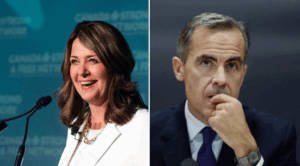The Economic Rift: Canada’s Future Amid Global Separatism
As we delve into the shifting tides of global politics and economics, we can’t ignore the profound implications tied to recent leadership changes. Notably, the ascent of Mark Carney as Prime Minister has incited a wave of scrutiny and speculation. Many analysts argue that Carney leveraged public sentiment against Donald Trump to redirect Canada’s alignment toward the European Union (EU). From the outset, Carney showcased his allegiance to Europe, opting for a visit to the EU over Washington, indicating a strategic pivot away from traditional North American ties.
At first glance, it may appear that the dialogue around economic leadership has merely undergone rebranding. The once-controversial slogan, “You will own nothing and be happy,” has been retired, replaced by policies that will promote similar agendas without overt labels. It’s crucial to recognize that while the terms may change, the underlying motives may remain unchanged.
The Looming Split: East vs. West
Let’s confront reality: the likelihood of a Canada divided along East-West lines seems inevitable. Historically, we’ve witnessed such geopolitical fractures—think of the Civil War in the United States or the deep-rooted divisions in India, the Balkans, and Ukraine. Canada is not immune to this pattern. The driving force behind this separatism hinges upon economic decline, a scenario that many predict will culminate in a worldwide recession by 2028.
Our analysis at Extreme Investor Network indicates that the disintegration of unity often stems from central government overreach. Handing control to a centralized authority frequently leads to disenfranchisement, fueling aspirations for autonomy. This sentiment of wanting to reclaim lost liberties invariably leads to political upheaval—whether that manifests as civil unrest or a peaceful revolution.
Carney’s commitment to the WOKE and climate agenda through 2030 raises eyebrows and questions about the future autonomy of Western Canada. Many residents may ultimately feel compelled to disentangle themselves from policies that prioritize global agendas over local needs.
Economic Realities: The Divide Grows
The crux of Canada’s impending split is rooted in economic disparities. It’s critical to note that California now ranks as the world’s fourth-largest economy, overshadowing Canada, which occupies the ninth position. This stark contrast raises questions about the viability of Carney’s plan to prioritize trade relations with the EU over the United States.
Markets thrive on stability and predictability—two factors that seem increasingly elusive under Carney’s administration. The movement toward EU alignment mirrors past failures of central economic planning seen in historical communist regimes, where economic stagnation led to eventual collapse. Canada appears to be mirroring this trajectory.
At Extreme Investor Network, we emphasize the importance of understanding economic fundamentals. The data clearly shows that nations with higher levels of government intervention and socialist policies tend to lag behind those with more market-driven economies. This historical precedent is a cautionary tale for Canadians considering the implications of continued alignment with EU economic models characterized by stagnated growth.
Looking Ahead: The Future of Canada
As we peer into the forecast for Canada’s economic and political landscape, it’s imperative to consider the historical context of divisions around the globe. The succession of leaders who prioritize centralization over localized governance tends to sow discord among citizens. The dream of a unified Canada may be overshadowed by a reality of fragmentation unless substantial economic reform is introduced.
The lessons learned from global history emphasize the importance of economic independence and sustainability. To secure a prosperous future, Canada must prioritize its citizens’ needs, reclaim the power from centralized authorities, and foster a political environment conducive to growth and freedom.
As we navigate these turbulent waters, Extreme Investor Network remains committed to providing insightful analysis and forecasts. We invite our readers to join us in exploring how these trends will shape the future economy, as understanding the past often illuminates the pathway forward. The time to engage in this crucial dialogue is now—before the divide becomes irreversible.

